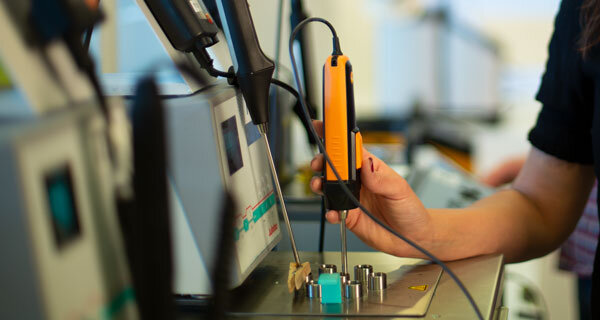
What is field calibration?
Field calibration means that we calibrate data loggers and sensors at your site. It is a convenient solution if you have measuring equipment that is difficult and time-consuming to dismantle or if you cannot be without your instruments if they were to be calibrated in our lab instead.
Field calibration also helps to minimize disruption to your operations. At your site, we use different calibration methods that have been approved by the Swedish national accreditation body Swedac. We are accredited for the following field calibrations:
- Temperature: -100 … +1200 °C
- Humidity: 5 … 95 %RH (at 15 … 40 °C) and 10 … 95 %RH (at 0 … 70 °C) – low measurement uncertainty!
- Differential pressure: -1000 … +1000 Pa
“We never know what to expect” – read the interview with calibration engineer Linda Wiman about the varied and exciting work of field calibration.

Contact person
Measurands for field calibration
Here are the quantities we can calibrate during field calibration – on site at your premises! Which instruments and quantities do you need calibrated? Get in touch and we will do our best to solve your calibration needs.
Temperature
All kinds of temperature meters and data loggers where we have the possibility to read out results. Calibration is performed by comparison measurement in liquid or temperature chamber.
Moisture
Most types of moisture measuring instruments, data loggers, transmitters and pressure dew point meters. We can issue a wide range of calibration certificates and certificates.
Pressure
We calibrate pressure, both accredited and traceable. It includes, for example, pressure gauges and other pressure measuring instruments and sensors of all makes.
Our methods during field calibration
Method MM5.3 – liquid bath temperature measurement
In a block oven, we heat a bath of oil to a certain temperature. We then measure the temperature in the liquid bath with our own highly accurate reference sensor and simultaneously with the customer’s sensor, and compare the values.
Method MM5.4 – measurement of air temperature and humidity
Here we use a so-called huminator. It has a closed chamber where a controlled environment with a certain level of temperature and/or humidity is created. The Huminator can be used to check moisture and temperature measuring instruments and sensors, either by inserting them through openings in the lid or placing them in the chamber.
Method MM5.8 – temperature measurement with dry blocks
Also for this method we use a block oven heated to a certain temperature (see Method MM5.3). But instead of a liquid insert, we have a dry block with drilled, temperature-stable holes. The drill holes have different dimensions and fit most common sensors on the market.
Method MM5.15 – comparison measurement with logging reference instruments
We use this method when dealing with hard-to-reach or permanently installed sensors that cannot be taken down easily for calibration. We then mount our logging reference instrument next to the customer’s sensor. After a certain acclimatization time, we read and compare the values from the customer’s equipment and our reference equipment.
Calibration at 0 °C with ice bath in special thermos flask
Some field missions, such as ice cream manufacturers, may require temperature calibration at 0°C. We usually use a well-insulated special thermos that we fill with an ice bath. We then measure the temperature in the ice bath with our highly accurate reference instrument and simultaneously with the customer’s sensor. And compare how close the sensor is to the measured value from the reference instrument.
Before and during a calibration
No two activities are exactly the same. Therefore, we need to ensure certain things before and during your calibration. This is a general outline for a field calibration.
Important preparations
Choice of measurement method: we always start by identifying the number of meters/sensors involved and making a list of the make, model and serial number of each unit. Once this is done, we will agree with you on the measurement method to be used.
Measuring points and data: by studying drawings and discussing with you, we get an idea of how the sensors are used, where they are located (if the calibration may also cover several properties and/or geographical locations) and which measuring points should be included in the calibration. We also need to know if measurement data can be read out on site or if this is done elsewhere.
Calibration environment: in order to perform the calibration safely and efficiently, we need to know what the environments are like. Based on this knowledge, we can then carry out the calibration correctly dressed with disposable lab coats, safety shoes and helmets, high-visibility vests and harnesses, hats and gloves – or whatever clothing and protective equipment is required in your premises.
When it is time for calibration
Equipment requirements: during the calibration, we need to have a workspace in the form of a table or a rolling trolley. To access and measure high up on shelves and pallet racks, we sometimes need a skylift. In other spaces, a ladder may be sufficient. It is up to you to make sure that these tools are close at hand for us during the calibration. If necessary, we have informed you in advance if we need login details for your metering system software.
Do not hesitate to contact us if you need help with a field calibration!



